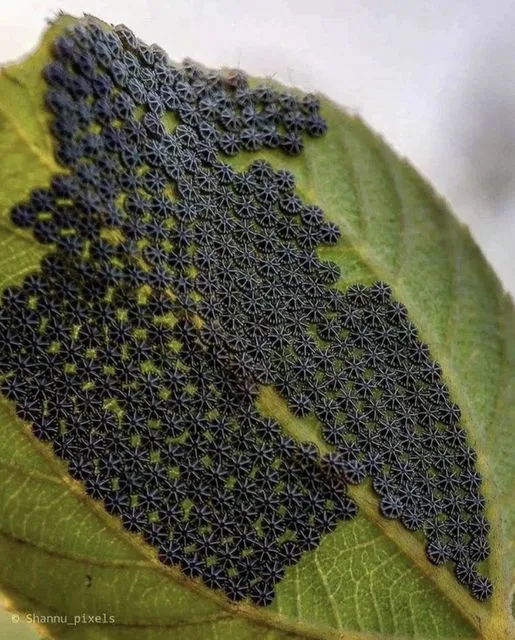I am usually seen in my garden; it is where I find refuge. I love gardening so much because it is incredibly satisfying to take care of plants, see them grow, and watch the results of my labor bloom. Let us not sugarcoat it, though—there may be difficulties, particularly with regard to pests. For gardeners such as myself, distinguishing between useful and destructive bugs is an ongoing challenge.

Lately, an intriguing picture has been circulating on social media, causing confusion and curiosity. It showed a leaf decorated with very detailed black geometric motifs. It seemed, at first view, to be alien or perhaps suffering from some mysterious illness. Its origin puzzled many, myself included.
After conducting further investigation, I discovered the reason for these mysterious patterns—they were, in fact, Nymphalis Antiopa butterfly eggs. Permit me to share some information about this fascinating species. The Nymphalis Antiopa, also known as the Mourning Cloak butterfly, is characterized by its unique life cycle and captivating habits.
To begin with, the eggs. It showed a close-up of these eggs on a leaf, looking like thin black lace softly spread across its surface. Their beauty was shown once the initial shock faded. When arranged in groups, every egg exhibits incredible geometric accuracy. At first, I thought about how they may affect my garden and alternated between excitement and fear.
Luckily, gardeners may enjoy the benefits of the Nymphalis Antiopa butterfly. Although its larvae, or caterpillars, consume leaves, willows, elms, and poplars are among the trees and shrubs that they seem to like. Therefore, their ravenous appetite is usually spared from gardens brimming with flowers and vegetables. Furthermore, these butterflies are an unexpected ally in the gardening world since they eat rotten fruit, which aids in decomposition and contributes to ecological balance.

Observing these butterflies during their whole life cycle is fascinating. Once they hatch from those strange, complex eggs, the caterpillars emerge. They are black with tiny white spots, and their bodies are spiky and bristly. They go through a sequence of events known as instars, when they enlarge and shed their skin.
When the caterpillars reach adulthood, they choose a safe place to pupate. Inside a chrysalis, which resembles a small sleeping bag, they transform themselves. The duration of this stage might range from a few weeks to several months, based on the climate and season. When they finally show themselves, they are magnificent Mourning Cloak butterflies, with dark, velvety wings that are flecked with blue and have a bright yellow border around them.
One of the most intriguing things about Mourning Cloak butterflies is their behavior. Unlike many other species, these butterflies hibernate over the winter. They find a cozy hiding spot in a pile of wood, beneath loose bark, or beneath an old shed. Oftentimes even before the flowers open, they are among the first butterflies to emerge in the spring. Their early appearance lends them the name “Mourning Cloaks,” as their black, melancholic wings, evoking a mourning garment, contrast sharply with the harsh, early spring surroundings.
As gardeners, we often focus on the immediate effects that insects have on our plants. We worry that caterpillars will eat everything when we see them. But it is important to take a step back and look at the bigger picture. The Nymphalis Antiopa butterfly is a great example of how equilibrium is preserved in nature. The caterpillars will not totally ruin your garden, even if they will eat some of the leaves. In fact, by providing a home for these butterflies, you are enhancing the ecology.
So what should you do if you find these eggs or caterpillars in your garden? I think you should leave them alone. Enjoy the process and note the transformation. If you are really worried about your plants, you can carefully move the caterpillars to a tree or shrub where they will be happy and less likely to devour your precious blossoms.

In gardening, balance is crucial. It is about coming to terms with your coexisting creatures and beloved plants. When you see something strange in your yard the next time, investigate it a bit before using a pesticide. Just like when I found the Nymphalis Antiopa butterfly eggs, you might find something very amazing.
In the end, everything is a part of the journey. The wealth of each season, along with its challenges, is what makes gardening so rewarding.
H/T : worthyshared.com



